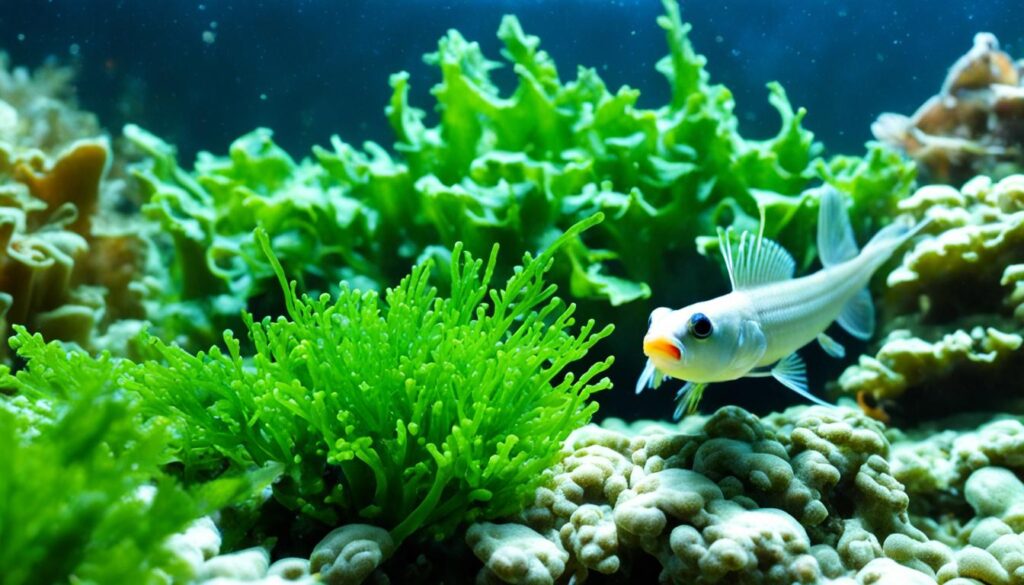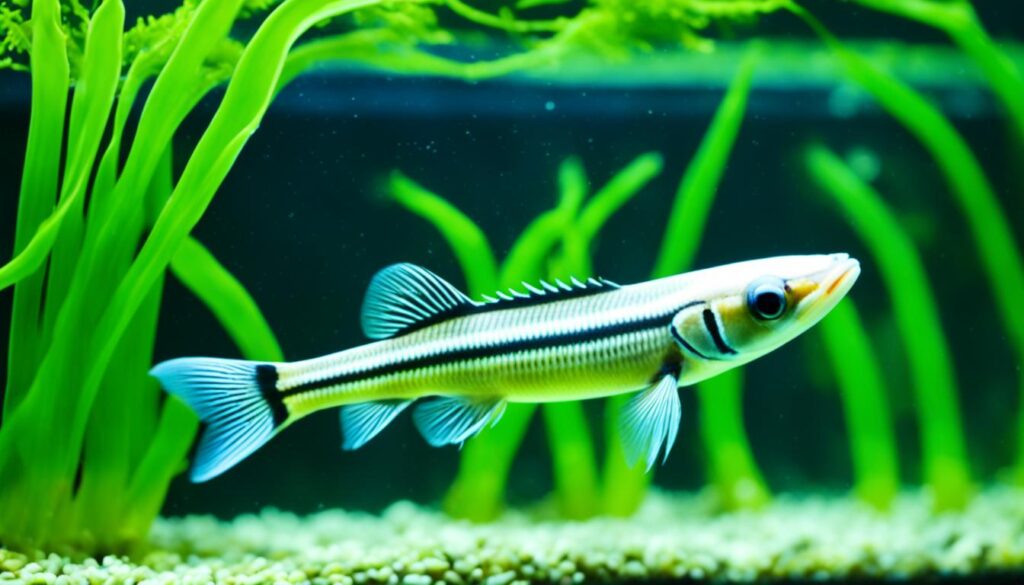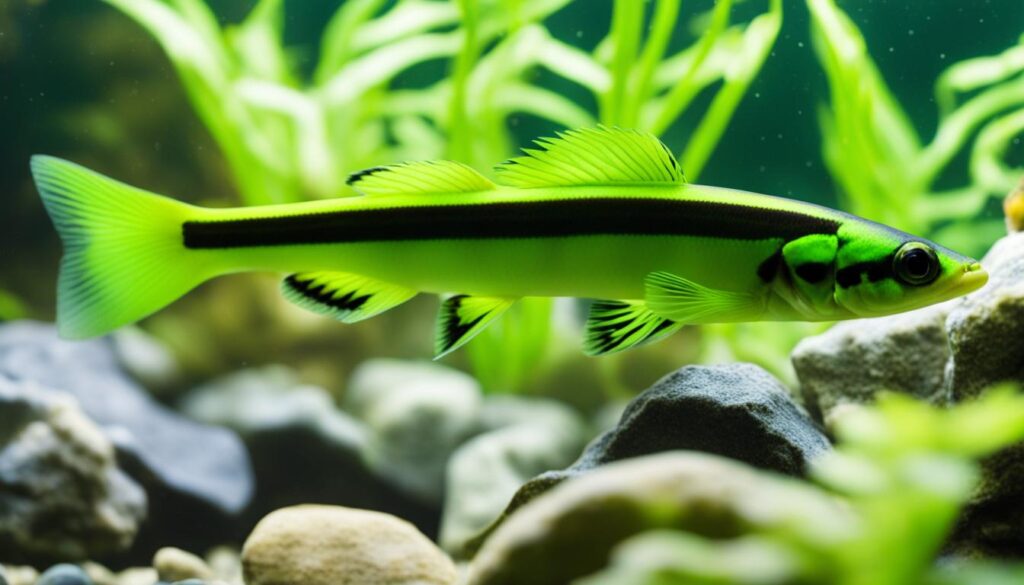Are you tired of battling algae in your aquarium? Meet the Siamese Algae Eater, the ultimate weapon against unwanted algae growth. But what exactly are Siamese algae eaters, and how can you provide the best care for them? Let’s dive in and explore the world of this remarkable freshwater fish.
Key Takeaways:
- Siamese algae eaters are popular freshwater fish known for their ability to control algae growth.
- They require suitable tank conditions, a balanced diet, and compatible tank mates for their optimal well-being.
- Siamese algae eaters have a lifespan of up to 10 years with proper care and maintenance.
- Breeding Siamese algae eaters in captivity is challenging and requires specific conditions.
- Regular observation, maintenance, and monitoring are essential for the health and longevity of Siamese algae eaters.
Siamese Algae Eater Appearance and Behavior
Siamese algae eaters, also known as Crossocheilus oblongus, are not only functional in maintaining aquarium cleanliness, but also possess a striking appearance. These freshwater fish have a sleek and torpedo-shaped body, resembling a miniature freshwater shark. Along their side runs a bold black line, contrasting against their tannish-gray back and lighter-colored belly. Their distinct coloring makes them a visually appealing addition to any aquarium.
Siamese algae eaters are active swimmers and exhibit shoaling behavior, meaning they swim in close groups. They are often found at the bottom of the tank, constantly searching for algae and food particles on various surfaces. Their bottom-dwelling behavior makes them efficient cleaners, ensuring the removal of unwanted algae from the tank.
While generally peaceful, Siamese algae eaters can display territorial behavior towards their own kind. As they establish a hierarchy within the group, aggression between individuals may arise, necessitating care when introducing multiple Siamese algae eaters to the same tank.
Siamese Algae Eater Size
Siamese algae eaters have the potential to grow up to 6 inches in length, making them a larger species in the aquarium trade. It is important to consider their size when setting up the tank to ensure they have ample space to swim and thrive.
Siamese Algae Eater Behavior
The behavior of Siamese algae eaters primarily revolves around their feeding habits and social interactions within the tank. Their constant search for algae and food particles makes them active swimmers and diligent cleaners. Their peaceful nature allows them to generally get along well with other tank mates, but caution should be exercised when housing them with other Siamese algae eaters due to potential territorial conflicts.
In summary, Siamese algae eaters have a striking appearance with their sleek body and bold black line. They exhibit active bottom-dwelling behavior, constantly searching for algae and food particles. While generally peaceful, territorial disputes can occur between Siamese algae eaters. It is essential to consider their size and behavior when incorporating them into an aquarium community.
Setting up the Ideal Aquarium for Siamese Algae Eaters
Siamese algae eaters thrive in a well-established aquarium that provides them with the right environment to thrive and exhibit their natural behavior. To ensure their health and happiness, it’s important to set up the tank properly and consider their tank mates to create a harmonious ecosystem.
Size and Capacity
A suitable tank size for Siamese algae eaters is at least 50-55 gallons. This size allows them to have enough swimming space and provides ample room for the required equipment and decorations. Remember that these fish can grow up to 6 inches in length, so a larger tank is ideal to accommodate their size.
Water Parameters
Siamese algae eaters are hardy fish and can tolerate a wide range of water parameters. However, maintaining stable and optimal conditions is crucial for their well-being. The recommended temperature for their tank is between 68–80°F (20–27°C), and the pH should be kept within the range of 6.0–8.0. They can adapt to both soft and hard water, but maintaining consistent water quality is essential.
Decorations and Hiding Places
Siamese algae eaters love exploring their environment and require hiding places to feel secure. Adding hardscape elements such as rocks, caves, driftwood, and live plants will provide them with plenty of spots to hide and graze. These decorations also mimic their natural habitat and create a visually appealing aquarium.
It’s important to create areas where algae and biofilm can grow for them to feed on. Algae-covered rocks and driftwood will be appreciated by these voracious algae eaters and help ensure their nutritional needs are met. Just make sure not to overfeed them to keep a balanced ecosystem.
Consider adding plants such as Java fern, Anubias, or Vallisneria to provide additional cover and create a more natural-looking environment. These plants are hardy and can withstand the occasional nibbling from Siamese algae eaters.
Tank Mates and Compatibility
Siamese algae eaters are generally peaceful and can coexist with a variety of fish species. However, it’s important to consider their compatibility with other tank mates to avoid any aggressive interactions or conflicts.
Good tank mates for Siamese algae eaters include:
- Loaches
- Barbs
- Cichlids
- Livebearers
These species share similar water requirements and temperaments, making them suitable companions for Siamese algae eaters. However, it’s important to note that Siamese algae eaters may eat dwarf shrimp if kept together in the same tank.
Here’s a table summarizing some compatible tank mates for Siamese algae eaters:
| Tank Mate | Compatibility |
|---|---|
| Loaches | High |
| Barbs | Moderate |
| Cichlids | Moderate |
| Livebearers | Moderate |
When introducing new tank mates, it’s important to monitor their behavior closely. If any aggression or compatibility issues arise, it may be necessary to rearrange the tank or consider alternative tank mates.
Remember, creating a suitable and harmonious aquarium for Siamese algae eaters is crucial for their overall health and well-being. Providing the right tank conditions, decorations, and compatible tank mates will ensure that your Siamese algae eaters thrive and contribute to a balanced ecosystem.
Siamese Algae Eater Diet and Feeding
Siamese algae eaters, with their omnivorous nature, have a diverse diet that includes:
- Algae
- Plant matter
- Flakes
- Wafers
- Freeze-dried foods
- Frozen fish food
- Blanched vegetables
These algae eaters have a small mouth that allows them to search for small food particles and algae. Juveniles require more nutrients to grow, so they consistently forage for food. As they reach adulthood, their appetite for algae decreases. However, the feeding habits can be encouraged by:
- Cutting back on their meal portions
- Fasting them for a week
Proper feeding ensures the nutritional needs of Siamese algae eaters are met, contributing to their overall health and vitality.
Tips for Feeding Siamese Algae Eaters:
“Siamese algae eaters thrive on a balanced diet that meets their nutritional needs. By providing a variety of food options and incorporating occasional fasting, you can keep your Siamese algae eaters healthy and happy.”
Here is an example of a recommended feeding schedule for Siamese algae eaters:
| Day | Feeding |
|---|---|
| Monday | Algae wafers |
| Tuesday | Blanched vegetables |
| Wednesday | Flakes |
| Thursday | Frozen fish food |
| Friday | Fast |
| Saturday | Algae |
| Sunday | Freeze-dried foods |
Following a consistent feeding routine and providing a balanced diet will contribute to the overall well-being of your Siamese algae eaters.

Siamese Algae Eater Tank Requirements
Creating the ideal tank environment for Siamese algae eaters is key to ensuring their health and well-being. Here are the tank requirements to consider:
Tank Size
Siamese algae eaters thrive in a tank of at least 50-55 gallons. The larger tank size provides ample swimming space and allows for a more stable and balanced ecosystem.
Water Conditions
Maintaining suitable water conditions is crucial for the optimal health of Siamese algae eaters. The recommended water temperature for them is between 68–80°F, while the pH should range from 6.0–8.0. It’s important to regularly monitor and adjust these parameters to ensure their comfort and well-being.
Preferred Habitat
Siamese algae eaters prefer a tank with clear streams and ample algae and biofilm growth on rocks and driftwood. These natural grazing areas provide them with the nutritious food they need to thrive and maintain a balanced diet.
Maintenance
Keeping the tank well-maintained is crucial for the overall health of Siamese algae eaters. Regular water changes, filtration, and cleaning are essential to maintain optimum water quality and prevent the buildup of harmful substances that can negatively affect their well-being.
Hiding Places
Providing ample hiding places is important for Siamese algae eaters to reduce stress and create a sense of security. Rocks, plants, and driftwood can be strategically placed in the tank to offer hiding spots for the fish.
In summary, a well-maintained tank with appropriate size, water conditions, and natural grazing areas is essential for the thriving of Siamese algae eaters. By providing them with the proper environment, you can ensure their health and longevity in your aquarium.
Siamese Algae Eater Breeding
While Siamese algae eaters are popular aquarium fish for their ability to control algae growth, breeding them in captivity can be challenging and is not commonly done. These fish are not internally fertilizing, which means specific conditions are required for successful breeding.
To breed Siamese algae eaters, you need a large, well-maintained tank with optimal water parameters and both male and female fish present. Breeding typically occurs during the rainy season in their natural habitat. It is important to consult with experienced breeders or seek expert advice to increase the chances of successful breeding.
Breeding Requirements
Successful breeding of Siamese algae eaters requires the following:
- A large and spacious tank with adequate swimming and hiding spaces.
- Optimal water parameters, including temperature, pH level, and water hardness.
- The presence of both male and female fish.
- The right time of year, ideally replicating the rainy season.
Breeding Siamese algae eaters in captivity can be a complex process. Providing the necessary conditions and seeking expert guidance will improve the chances of a successful breeding attempt.
Siamese Algae Eater Lifespan and Care Tips
Siamese algae eaters, also known as Crossocheilus oblongus, have a lifespan of up to 10 years with proper care and maintenance. To ensure their well-being, it is essential to provide them with a suitable tank size, proper diet, and compatible tank mates.
Siamese algae eaters require a tank capacity of at least 50-55 gallons. This size allows them ample swimming space and the opportunity to establish a natural territory. A larger tank also helps maintain water quality and stability. It is important to monitor and maintain proper water parameters, including temperature (68–80°F) and pH (6.0–8.0) levels, to ensure optimal health for the algae eaters.

Diet and Feeding
Siamese algae eaters are omnivorous and have a diverse diet. They primarily consume algae and can effectively control its growth in the aquarium. However, it is important to supplement their diet with other food options to ensure their nutritional needs are met.
Offer them a combination of high-quality flakes, wafers, freeze-dried foods, frozen fish food, and blanched vegetables. It is recommended to provide a variety of food sources to mimic their natural feeding behavior and keep them engaged. While they primarily feed on algae, they may also consume small food particles and biofilm from tank surfaces.
Ensure a regular feeding schedule and provide small meals throughout the day to mimic their continuous foraging behavior.
Compatibility and Tank Mates
Siamese algae eaters are generally peaceful fish but can display territorial behavior towards their own kind. It is best to keep them in small groups of three or more to encourage shoaling behavior and reduce aggression.
When choosing tank mates, consider species that are compatible with siamese algae eaters’ behavior and size. Avoid keeping them with aggressive or fin-nipping fish. Examples of suitable tank mates include loaches, barbs, cichlids, and livebearers. However, take precaution with dwarf shrimp, as siamese algae eaters may consume them.
Monitoring and Health Care
Regular observation of siamese algae eaters’ behavior is important to detect any signs of illness or stress. Look out for changes in appetite, abnormal swimming patterns, or physical abnormalities.
Monitor water quality parameters regularly and perform regular water changes to maintain a clean and healthy environment for the fish. Adequate filtration is crucial for removing waste and maintaining water clarity.
If any health issues arise, seek veterinary assistance from a professional experienced in fish care.
| Care Tips for Siamese Algae Eaters |
|---|
| Provide a tank size of at least 50-55 gallons for ample swimming space. |
| Maintain water temperature between 68–80°F and pH levels between 6.0–8.0. |
| Offer a variety of food sources including algae, flakes, wafers, and vegetables. |
| Monitor behavior and health, and seek veterinary assistance if needed. |
| Keep them with suitable tank mates that are compatible with their behavior. |
Conclusion
Siamese algae eaters are a popular choice for freshwater aquariums due to their ability to effectively control algae growth. To ensure the well-being of these fish, it is essential to provide them with proper care and maintenance.
Start by creating a suitable tank environment. Siamese algae eaters thrive in tanks that have a capacity of at least 50-55 gallons and offer plenty of hiding places and swimming space. It is also important to maintain optimal water conditions, including a temperature range of 68–80°F and a pH level of 6.0–8.0.
When it comes to their diet, Siamese algae eaters are omnivorous. They enjoy a varied diet consisting of algae, plant matter, flakes, wafers, and even blanched vegetables. It is important to monitor their feeding habits and adjust accordingly as they mature.
Siamese algae eaters are generally peaceful and compatible with various tank mates such as loaches, barbs, cichlids, and livebearers. However, they may exhibit aggression towards their own kind as they establish a hierarchical order. Observing their behavior and providing appropriate tank mates is key to maintaining a harmonious community tank.
With proper care and attention, Siamese algae eaters can live up to 10 years. Regular monitoring of water quality, observing their behavior for signs of illness, and seeking veterinary assistance if needed are essential for their long-term health.
By following these care tips and taking the time to understand their needs, you can enjoy the beauty and benefits of having Siamese algae eaters in your aquarium while maintaining a clean and well-balanced ecosystem.

